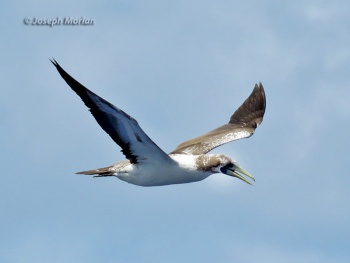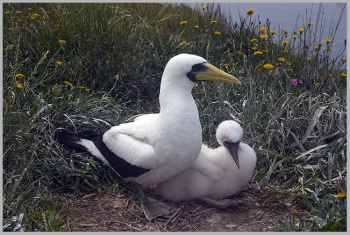- Sula dactylatra
Identification
L. 81 cm (32 in)
Ws. 158 cm (62 in)
Adult Masked Booby shows a white body, black tail, and black on wings that is limited to flight feathers (as seen from above and below) and the greater coverts on the upperside of the wing. Bill is yellow surrounded by black facial skin producing the mask. Legs vary from yellow to olive to dark grey depending on subspecies.
Immatures have brown upper body with brown head, similar to molting young Northern Gannets, but have a pale collar and white rump. Underside is white with black flight feathers and a dark bar in the middle of the underwing coverts. Bill is dusky and feet are grayish.
Similar Species
Immature Masked Booby can be similar to Brown Booby, but notice that the first has a white collar across the back just in front of the wings which Brown Booby does not show, and that bill color is dark in Brown where it is yellowish in Masked booby.
Distribution
This species is found in the Caribbean, the Atlantic Ocean, the Indian Ocean, and parts of the Pacific Ocean as well as around the northern parts of Australia; mostly or exclusively tropical in its range.
A rare and local year round resident in the West Indies with a total breeding population estimated to between 500 and 1700 pairs. In the Caribbean, known breeding areas are southern Bahamas (probably not the last 100 years), Jamaica, Puerto Rico, Virgin Islands, Anguilla, Redonda in Antigua, and among the Grenadines; very rare elsewhere in the West Indies.
Taxonomy

Photo © by Joseph Morlan
Philippine Sea off Minamidaitojima Island, Okinawa Prefecture, Japan, 5 September 2019
Previously, the Nazca Booby (Sula granti) was considered a race of the Masked Booby.
Subspecies
Four subspecies are recognized[1]:
- S. d. dactylatra is found in the Caribbean and the south-west Atlantic Ocean
- S. d. melanops is found in the western Indian Ocean
- S. d. personata in the central and western Pacific
- S. d. tasmani in the northern Tasman Sea.
Habitat
Pelagic.
Behaviour
Diet
Includes fish
Breeding
It nests mostly on flat terrain including scrapes in sand and 2 eggs are laid. Colonial nesting on islands and cays is the rule.
Vocalisation
Silent at sea. At breeding colony has reedy whistling greeting call.
Movements
Most adults remain within vicinity of colonies. However, young birds and some adults may wander considerable distances.
References
- Clements, J. F., T. S. Schulenberg, M. J. Iliff, S. M. Billerman, T. A. Fredericks, B. L. Sullivan, and C. L. Wood. 2019. The eBird/Clements Checklist of Birds of the World: v2019. Downloaded from http://www.birds.cornell.edu/clementschecklist/download/
- Abstract of the paper reporting identity of Tasman Booby with subspecies fullagari.
- Howell & Webb, 1995. A guide to the birds of Mexico and northern Central America. Oxford University Press. ISBN 0198540124
- Pizzey, G. & Knight, F. 1997. Birds of Australia (Collins Field Guide). HarperCollins Publishers, London. ISBN 0-00-220132-1
- Raffaele et al. 1998. Birds of the West Indies. Christopher Helm, London. ISBN 0713649054
- Brazil, M. (1991). The Birds of Japan. Smithsonian Inst. Press. Washington, D.C. ISBN 1-56098-030-3
- Brazil, M. (2018). Birds of Japan. Helm, London. ISBN 978-1-4729-1386-9
- Carboneras, C., Christie, D.A., Jutglar, F., Garcia, E.F.J. & Kirwan, G.M. (2019). Masked Booby (Sula dactylatra). In: del Hoyo, J., Elliott, A., Sargatal, J., Christie, D.A. & de Juana, E. (eds.). Handbook of the Birds of the World Alive. Lynx Edicions, Barcelona. (retrieved from https://www.hbw.com/node/52623 on 5 October 2019).
- Marchant, S. & Higgins, P.J. (co-ordinating editors) 1990. Handbook of Australian, New Zealand & Antarctic Birds. Volume 1, Ratites to ducks; Part B, Australian pelican to ducks. Melbourne, Oxford University Press. Pages 737, 748, 763-772; plates 56 & 58.
- Dutson, G. (2011) Birds of Melanesia, Christopher Helm, London.
Recommended Citation
- BirdForum Opus contributors. (2025) Masked Booby. In: BirdForum, the forum for wild birds and birding. Retrieved 13 May 2025 from https://www.birdforum.net/opus/Masked_Booby
External Links
GSearch checked for 2020 platform.1





